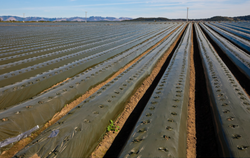As the appeal of more natural products continues to grow around the world, demand for US grown cotton leads the way. With that growing demand, however, comes responsibility.
Responsibility means continuing to provide the world’s premium cotton. US cotton growers have long prided themselves as offering the first fruits of a world class supply chain, providing more than two-thirds of the US crop to customers around the globe.
In a previous newsletter, we discussed extraneous contamination coming from the John Deere module cover primarily found in the bright yellow color John Deere is known for, but also in other colors, such as pink to promote breast cancer awareness. There has been much education centered on this problem for growers and ginners, and they are responding across the US with better methods for removing the cover at the gin. In addition, growers are more aware of module placement and handling. There is still much work to be done, but there are many farmers and ginners across the US that genuinely care about the quality of their cotton.
Even still, another extraneous contaminant has again reared its ugly head, creating problems in new markets for cotton. Cotton has long been the fiber of choice for clothing of all types, as well as sheets, towels, and washcloths. Now, with the greatly increased demand for natural fibers in hygiene products such as baby care, feminine care, and adult care offerings, black plastic is finding its way into the cotton supply stream. Just imagine a baby diaper with black specs throughout the inner and outer cover where consumers expect only the purest of products!
The black plastic comes from cotton grown on land previously farmed for a crop that required ground cover, like watermelons or strawberries. The contamination problem arises from the fact that the black plastic is often tilled under, only to resurface when the cotton plant emerges, becoming a part of the cotton plant. At season’s end, the cotton pickers harvest not only cotton lint and seed, but black plastic as well.
Naturally, the US Department of Agriculture is giving a lot of attention to these findings around extraneous contamination, and the agency is applying more scrutiny to samples submitted to the classing offices. The US cotton industry as a whole is creating more awareness of these contaminants and working together to eliminate this problem.
At Barnhardt Purified Cotton, we’re doing our part, too. We are doing all we can to protect our customers from contaminants, by eliminating them through our purification process. In addition, we work with cotton growers, ginners, and merchants that we have identified as partners in our initiative to provide the cleanest, purest cotton to the nonwoven market.
